Abstract
This study investigated the effects of incorporating reduced-graphene-oxide-coated alumina (Al2O3–RGO) nanoparticles and unmodified graphene oxide (GO) onto the microstructure as well as the mechanical properties of Al2O3/TiB2 matrix ceramic materials. The microstructure observation revealed that, compared with GO addition, the addition of Al2O3–RGO nanoparticles significantly improved RGO dispersion in the ceramic materials and reduced defects such as pores caused by graphene agglomeration. In addition, the uniformly dispersed RGO nanosheets were interwoven with each other to form a three-dimensional grid structure due to grain growth and the disappearance of pores during sintering, which increased the contact area and interface-bonding strength between the RGO and ceramic matrix. According to the results of microstructure observation and analysis, the good interfacial strength not only facilitated load transfer from the ceramic matrix to the RGO but also induced the fracture mechanism of the RGO, which consumes more fracture energy than the traditional toughening mechanism. The results of mechanical properties analysis showed that the hardness, flexural strength, and fracture toughness of the obtained ATB–RG3.0 ceramic material was measured at 19.52 GPa, 1063.52 MPa, and 9.16 MPa·m1/2, respectively. These values are 16.82%, 27.92%, and 26.87% higher than those of the ceramic material with 3.0 vol.% GO.
1. Introduction
Al2O3-based ceramic materials have become one of the most promising materials because of their high wear resistance, high temperature resistance, corrosion resistance, and oxidation resistance [1,2,3]. However, their inherent brittleness and poor thermal shock resistance severely limit their widespread application in the field of engineering structures [4]. Hence, considerable research efforts have been directed towards enhancing the toughness of ceramic materials [5]. The addition of materials such as carbides, metals, whiskers or fibers to ceramic materials has been the most commonly adopted method to improve the mechanical characteristics of ceramic materials [6,7,8,9]. Unfortunately, the reinforcement efficiency has not yet met the application requirements satisfactorily.
Graphene, a two-dimensional nanomaterial with hexagonal carbon atoms, is generally considered to be one of the ideal candidates for ceramic materials due to its excellent optical, thermal, electrical, and mechanical properties [10]. Over the past two decades, many studies have shown that adding an appropriate amount of graphene nanoplatelets to ceramic materials can have a positive effect on the mechanical properties of materials [11]. Even though graphene enhances the mechanical properties of ceramic materials, two key issues persist for practical applications. On the one hand, when graphene is used as a filler for ceramic materials, its excellent properties are obscured due to the inefficient dispersion caused by the restacking of these sheets, thus reducing the enhancement efficiency of graphene on ceramic materials [12]. On the other hand, the existence of a graphene filler threshold makes it difficult to increase mechanical strength because it reduces the favorable influence on the high density of ceramic materials, which leads to microcracks and limited mechanical strength. Graphene is particularly susceptible to interfacial bonding characteristics owing to its wide specific surface area and high aspect ratio, which in turn increase the material’s toughening efficiency [13]. Therefore, in order to fully realize the enhancement potential of graphene for ceramic materials, these two bottlenecks must be addressed.
Numerous studies have shown that nanoparticles can be coated by the surface of graphene or its derivatives through chemical bonding or other interactions to form core–shell structures [14]. Nanoparticles are effective carriers of graphene because the surface energy of nanoparticles in the core–shell structure can be minimized, which is conducive to prevent re-stacking of graphene in matrix material [15,16,17,18]. The core–shell structure of graphene-coated nanoparticles prepared by various processes can not only achieve good dispersion effect of graphene but also improve the interface compatibility between graphene and matrix material, thus enabling graphene to enhance the function and mechanical properties of matrix material [19,20,21,22]. In general, core–shell structures are ideal for achieving synergies, but surprisingly little attention has been paid to the application of core–shell structures in ceramic materials. In view of the advantages of graphene-based core–shell structures, if one or several layers of graphene with good mechanical properties can be pre-coated on the surface of the nanoparticles, core–shell composite nanoparticles of graphene-coated nanoparticles can be formed and then introduced into the ceramic matrix as a nano addition phase to prepare graphene-reinforced ceramic materials [23]. By means of this method, graphene and nanoparticles can work together to enhance the mechanical properties of ceramic materials. At the same time, these core–shell composite nanoparticles with a unique structure can effectively solve the problem of self-aggregation of graphene in ceramic materials and effectively improve the interface-bonding strength between graphene and ceramic materials [24].
It is difficult for graphene to evenly disperse in ceramic materials, and it is difficult to form a good contact interface between graphene and ceramic materials; in order to solve this problem, reduced-graphene-oxide-coated alumina (Al2O3–RGO) nanoparticles with a core–shell structure using a hydrothermal self-assembly method were synthesized in this investigation. These Al2O3–RGO nanoparticles were then added as a hybrid reinforcement phase to prepare ceramic materials with excellent mechanical properties. For comparative purposes, graphene oxide (GO) was used as the starting reinforcement phase to prepare in situ RGO-reinforced ceramic materials. By comparing it with ceramic materials with Al2O3–RGO nanoparticles, the influences of different graphene addition methods on the dispersion degree of graphene in ceramic materials, the microstructure and mechanical properties of ceramic materials were deeply analyzed, and then the strengthening and toughening mechanism of the mechanical properties of ceramic materials enhanced by Al2O3–RGO nanoparticles was revealed.
2. Experimental Section
2.1. Starting Materials
Natural graphite (99.5%, 325 mesh) was purchased from Nanjing Xianfeng Nano Materials Co., Ltd. (Nanjing, China). Commercially available nanoscale α-Al2O3 (purity > 98.5%, particle size ~100 nm), sub-micron α-Al2O3 (99.9%, 200 nm), and sub-micron TiB2 (99.9%, 200 nm) were provided by Shanghai Chaowei Nanotechnology Co., Ltd. (Shanghai, China). Potassium permanganate (KMnO4, 99.5%), sodium nitrate (NaNO3, 99.9%), hydrogen peroxide (H2O2, 30%), absolute ethanol (C2H5OH, 99.9%), and γ-aminopropyltriethoxysilane (APTES, 99.9%) were purchased from Sinopharm Chemical Reagent Co., Ltd. Sodium hydroxide (NaOH, 99%), hydrochloric acid (HCl, 37%), and concentrated sulphuric acid (H2SO4, 98%) were provided by Shanghai Shenbo Chemical Co., Ltd. (Shanghai, China). All reagents were used as received without further purification.
2.2. Synthesis of Al2O3–RGO Nanoparticles
The Al2O3–RGO nanoparticles with core–shell structures were synthesized via a simple hydrothermal self-assembly method, as described in a prior study [25]. Briefly, a suspension with 0.5 mg·mL−1 of concentration was obtained by ultrasonically dispersing GO produced using a modified Hummer method in deionized water [26,27]. Furthermore, Al2O3 nanoparticles were ultrasonically dispersed in 150 mL of an ethanol–water solution (98/2, v/v) to form a suspension. An appropriate quantity of APTMS was subsequently added to the suspension after the pH had been adjusted to 4 to 5 with diluted HCl. To obtain aminated Al2O3 nanoparticles, the mixture was filtered and washed after being refluxed at 78 °C with agitation for 10 h. A suspension containing 10 mg·mL−1 aminated Al2O3 nanoparticles was produced by ultrasonically dispersing an adequate quantity of it in deionized water. The two suspensions were mixed under ultrasound and agitation until dark brown flocculent precipitates appeared. Finally, Al2O3–RGO core–shell nanoparticles were obtained by calcining the product for 5 h at 650 °C under argon flow.
2.3. Sintering of Ceramic Materials
A schematic representation of the procedure employed to fabricate ceramic materials reinforced with Al2O3–RGO nanoparticles is shown in Figure 1. MgO and Y2O3 were applied in small amounts as sintering additives after sub-micron α-Al2O3 and TiB2 were dispersed ultrasonically in absolute ethanol. The slurry was wet-milled for 48 h using cemented carbide balls and ethanol as the medium. Furthermore, the required amounts of Al2O3–RGO nanoparticles and GO were dispersed separately in anhydrous ethanol mixed with the aforementioned slurry and then subjected to 2 h of ball milling. Thereafter, the resulting slurry was vacuum-dried in a 65 °C oven for 24 h and sieved through 200 mesh to obtain the composite particles. In addition, the composite particles were loaded into a graphite mold with a diameter of 36 mm and hot-pressed for 15 min at 1680 °C under a uniaxial pressure of 30 MPa.
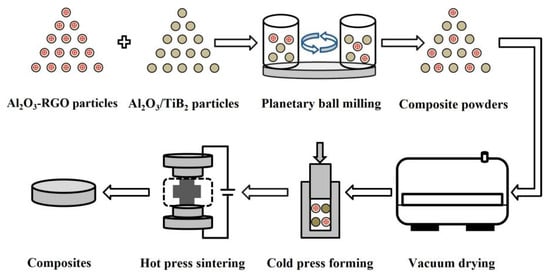
Figure 1.
Schematic of the preparation process of ceramic materials with Al2O3–RGO.
To simplify, the Al2O3/TiB2/Al2O3–RGO samples are hereinafter referred to as ATB–RGX series ceramic materials, where X is the graphene content in Al2O3–RGO nanoparticles (X = 0, 1.5, 3.0, and 4.5 vol.%). In addition, similar samples with GO instead of Al2O3–RGO nanoparticles were prepared. The resulting Al2O3/TiB2/GO samples were labeled ATB–GX series ceramic materials, where X (X = 1.5, 3.0, and 4.5 vol.%) is the amount of graphene converted by GO. Also, in order to determine the influence of the quality of Al2O3–RGO nanoparticles and GO on the composite material, the design of the powder mixture composition for different samples are shown in Table 1.

Table 1.
Composition ratio of the as-prepared ceramic materials (vol.%).
2.4. Mechanical Properties
The bulk density and theoretical density of the samples and doped samples were measured using an Archimedes method and the rules of the mixture, respectively, and the relative density of the samples was calculated by dividing the measured density by the theoretical density. A Vickers hardness tester was used to measure the Vickers hardness (HV) of the polished surface by applying a 196 N load for 15 s. The flexural strength (σf) of the materials was measured according to the three-point bending method using the samples in the form of rectangular bars (3 mm × 4 mm × 36 mm) with a span of 30 mm and a loading speed of 0.5 mm·min−1. The fracture toughness (KIC) of the materials was measured using a single-edge notched-beam method. The size of the sample was 2 mm × 4 mm × 22 mm. A small incision was made in the middle of the compression surface with a width of 0.2 mm and a depth of 2 mm. The movement speed of the card head was 0.05 mm·min−1, and the span was 16 mm. For each sample, at least five data points were collected, and the average value was given.
2.5. Microstructural Characterization
A JSM-7500F field emission scanning electron microscope (FESEMM, Zeiss Ultra-55, Germany) equipped with an energy-dispersive spectrometer (EDX) and a JEM-2100F transmission electron microscope (TEM, JEM-2100F, Japan) equipped with an energy-dispersive spectrometer (EDS) were employed to study the microstructure of the samples. X-ray photoelectron spectroscopy (XPS; HI Quadra SXM) was utilized to analyze the chemical compositions of the samples. Using a 532 nm laser excitation wavelength, Raman spectroscopy (Alpha300R, WITEC, Germany) was employed for the characterization of the graphene structure. The crystalline structure of the samples and their composition were studied via XRD (D8 ADVANCE, Bruker, Germany) using a Cu-Kα (λ = 1.5406 Å) radiation source in a scanning range of 10°–80° at a rate of 2 °/s. The sample was then prepared to investigate the grain size by hot etching and polishing the surface. Images obtained from FESEM were utilized to determine the mean grain size using the mean line interception method. At least 100 grains were measured for each sample, and the average grain size was calculated.
3. Results
3.1. Characterization of GO and Al2O3–RGO Nanoparticles
A schematic diagram of the microstructure of GO is shown in Figure 2. As can be seen from Figure 2a, the diameter of the original GO prepared by Hummer method is about 2 μm, and its structure shows an obvious wrinkled surface. As shown in Figure 2b, the wrinkled GO is structurally similar to a thin film, showing a special two-dimensional structure, which greatly increases the specific surface area and saturation load of GO. A representative atomic force microscope (AFM) image of a typical thin GO is shown in Figure 2c. After ultrasonic treatment, the thin GO unfolds into small sheet with a diameter of 2–3 μm. The GO was folded because of the significant variations in thickness along the measuring line, as clearly shown in Figure 2d. In addition, measurements and statistics showed that the average thickness of GO was roughly 1.0 nm, indicating that GO exists in the form of completely peeled sheets in water [28]. This thickness is larger than that generally observed for single-layer graphene, which is approximately 0.35 nm, most likely owing to the abundance of oxygen-containing functional groups on the surface and edge of GO [29].
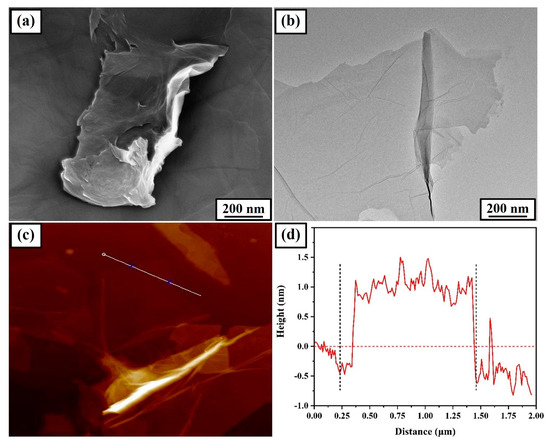
Figure 2.
Microstructure diagram of GO: (a) FESEM, (b) TEM, (c) AFM, and (d) height.
The synthesis process of Al2O3–RGO nanoparticles prepared by self-assembly method is shown in Figure 3a. The surface of GO is negatively charged by adjusting the pH value of the solution, and then the surface of the aminozed Al2O3 nanoparticles is adhered to by GO through electrostatic interaction and hydrogen bonding. After calcination in N2 atmosphere, GO is reduced to RGO and a graphene-coated nanoparticle with a core–shell structure is formed. As shown in Figure 3b, the surface of the original Al2O3 nanoparticles is relatively rough and its size is 100 nm. It can be seen from Figure 3c that the surface of the Al2O3 nanoparticles presents a wrinkled morphology, which is evidence that the Al2O3 nanoparticles are covered by RGO nanosheets. An obvious carbon peak appears in the EDS spectrum of the Al2O3–RGO nanoparticles, which further indicates that the Al2O3 nanoparticles are coated with RGO nanosheets. As shown in Figure 3e, a distinct core–shell structure can be seen, although there is no irregular structure and agglomeration. From Figure 3f, we observe that the average thickness of the surface shells of these nanospheres is about 5 nm, indicating that the Al2O3 nanoparticles are well wrapped in RGO nanosheets. In the HRTEM image (Figure 3g), the lattice streaks are observed at distances of 0.25 nm and 0.35 nm, respectively, which are attributed to the D-distances of the Al2O3 crystal (100) crystal plane and the graphene (002) crystal plane, indicating that these Al2O3 nanoparticles are well coated in the RGO nanosheets.

Figure 3.
Schematic illustration of the synthesis route of Al2O3–RGO (a), FESEM image of Al2O3 (b), FESEM image (c), and EDX spectra (d) of Al2O3–RGO and TEM images (e,f) and HRTEM images (g) of Al2O3–RGO.
The test results of chemical characteristics and bonding structure of GO and Al2O3–RGO nanoparticles were analyzed in Figure 4. Figure 4a shows the X-ray diffraction (XRD) patterns of GO and Al2O3–RGO nanoparticles, where GO has a wide diffraction peak at 2θ = 11°, which is attributed to the (001) crystal plane of GO, indicating that graphite powders are oxidized to GO [30]. According to the XRD pattern of Al2O3–RGO nanoparticles, the characteristic peaks at 26.1°, 35.3°, 43.4°, and 57.5° are derived from the (012), (104), (113), and (166) crystal planes of α-Al2O3 crystal structure (JCPDS No. 01-078-2426), which indicated that the composite particles contain Al2O3 crystals. In addition, the XRD pattern of the Al2O3–RGO nanoparticles has a characteristic peak corresponding to the (002) crystal plane of graphite at 2θ = 26.1°, and this shift of the characteristic peak demonstrates that the GO has been successfully reduced to RGO [31]. The weight loss of GO in the temperature range of 25 °C to 800 °C is estimated to be 12.27 wt.% from the TGA curve (Figure 4b), as the weight loss is mainly caused by the loss of physical adsorption water molecules and the decomposition of oxygen-containing functional groups. Due to the enhanced interlayer van der Waals forces caused by the loss of physical adsorbed water and the elimination of perspiration and oxygen functional groups, Al2O3–RGO nanoparticles have higher thermal stability than GO [32]. In the XPS spectra of the Al2O3–RGO nanoparticles, only significant C1s, O1s, and Al2p peaks were detected (Figure 4c), indicating that the hybrid material was composed of Al2O3 nanoparticle and RGO. The XPS analysis of C1s peak for GO and Al2O3–RGO core–shell nanoparticles, as depicted in Figure 4d, reveals the presence of three distinct peaks seen at 284.7 eV, 286.1 eV, and 289.7 eV. These peaks were attributed to the C–C, C–O, and O–C=O bonds [33,34], respectively, with atomic concentrations of 72.01%, 20.05%, and 7.93%. In addition, O content in Al2O3–RGO decreased to 27.98%, contributing to the effective RGO coating on the Al2O3 nanoparticle surface.

Figure 4.
X-ray diffraction patterns (a), thermogravimetry analysis (b), survey XPS spectrum (c), and C1s XPS spectra (d) of GO and Al2O3–RGO.
3.2. XRD and Raman Spectroscopy of the As-Prepared Ceramic Materials
The acquired XRD patterns for the ceramic materials with GO and Al2O3–RGO nanoparticles are displayed in Figure 5. The diffraction peaks of Al2O3 and TiB2 were intense and narrow, which indicated that these are the main crystalline phases of the ceramic materials. Moreover, the position and intensity of the observed diffraction peaks were stable, demonstrating that the addition of GO and Al2O3–RGO does not affect the phase composition of the prepared ceramic materials. The absence of any distinct diffraction peak in graphene can be attributed to the disruption of its crystallographically organized structure and the uneven arrangement of atoms in three-dimensional space [35,36].
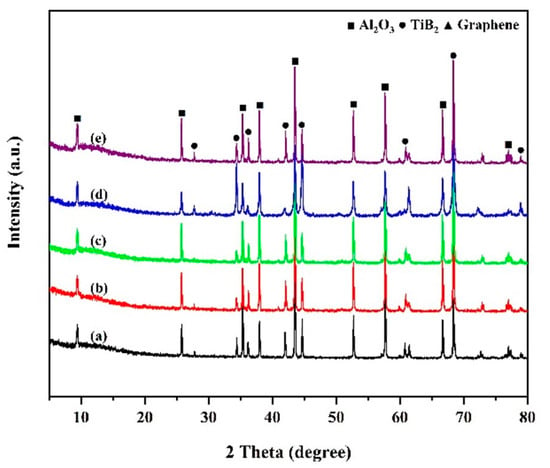
Figure 5.
XRD patterns of different ceramic materials: (a) ATB–RG0.0, (b) ATB–RG1.5, (c) ATB–RG3.0, (d) ATB−RG4.5, and (e) ATB–G3.0.
The obtained Raman spectra for the with GO and Al2O3–RGO-containing ceramic materials are displayed in Figure 6 indicates that these results indicated that the structure of graphene was preserved in the ceramic materials after sintering, which was confirmed by the existence of D, G, and 2D peaks in the spectra. Specifically, the D peak (found at 1350 cm−1) corresponds to a defect in the structure and a breakdown of hexagonal lattice symmetry, while the G peak (found at 1600 cm−1) shows the first-order E2g photon scattering resulting from sp2-hybridized graphitic carbon [37]. In addition, the Al2O3–RGO ceramic materials had a reduced D peak to G peak intensity ratio (ID/IG) compared with the GO-added materials, indicating that Al2O3–RGO effectively prevents the damage of graphene during sintering [38]. The number of graphene layers was found to decrease the 2D peak intensity [39]. Hence, the consistent rise in 2D peak intensity within ceramic materials containing Al2O3–RGO signifies that the incorporation of Al2O3–RGO can significantly enhance the graphene dispersion level.
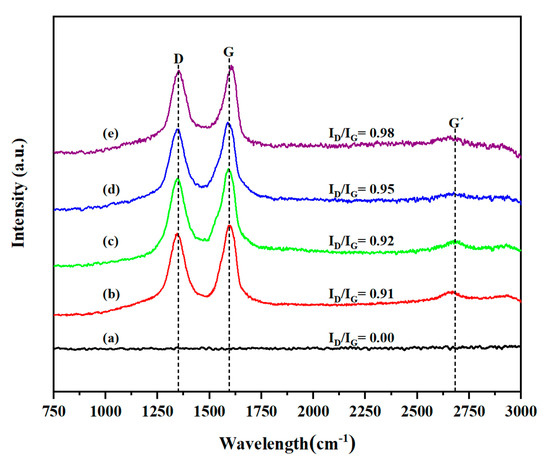
Figure 6.
Raman spectra of different ceramic materials: (a) ATB−RG0.0, (b) ATB−RG1.5, (c) ATB−RG3.0, (d) ATB−RG4.5, and (e) ATB−G3.0.
3.3. Microstructure of the As-Prepared Ceramic Materials
Images obtained from FESEM for the fracture surfaces of the prepared ATB–RGX series ceramic materials containing varying fractions of Al2O3–RGO nanoparticles are shown in Figure 7. As shown in Figure 7a,b, ATB–RG0.0 ceramic material without Al2O3–RGO is uniformly distributed in different phases without abnormal growth of grains. Figure 7c,d show that the ATB–RG1.5 ceramic material with 1.5 vol.% Al2O3–RGO has minimal porosity and tight grain bonding on the fracture surface. In addition, RGO nanosheets are uniformly distributed in the ceramic materials without obvious agglomeration. Figure 7e,f illustrate the good densification of the ATB–RG3.0 ceramic material with 3.0 vol.% Al2O3–RGO. During the sintering process, grain expansion and void disappearance cause evenly dispersed RGO nanosheets to interweave into a 3D RGO network structure across the whole material. This special structure makes it easier for RGO nanosheets to form a firm mechanical locking and interface adsorption with ceramic grains, thus greatly increasing the contact interface and improving the efficiency of load transfer between the two components [40]. As shown in Figure 7g,h, the porosity of the ATB–RG4.5 ceramic material containing 4.5 vol.% Al2O3–RGO increases considerably, which can be attributed to an excessive Al2O3–RGO content causing agglomeration owing to the van der Waals (vdWs) interactions present between the RGO nanosheets, leading to an increase in the porosity [41].
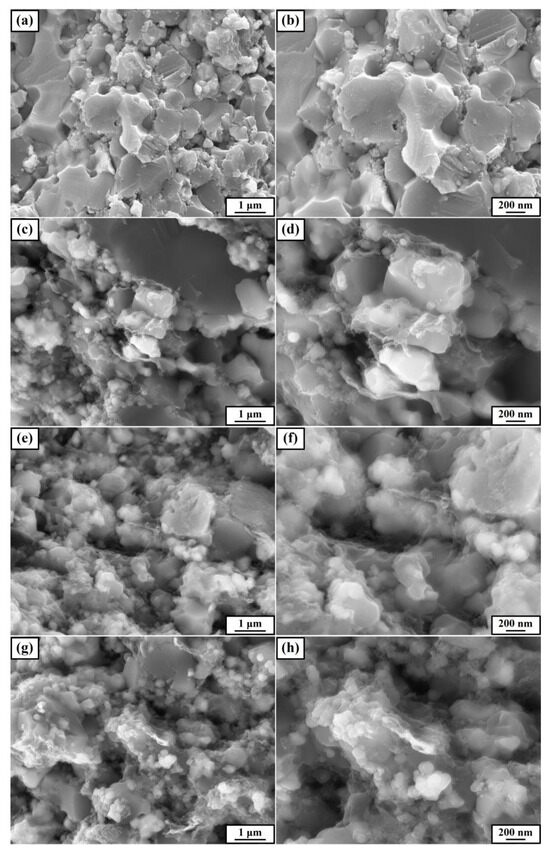
Figure 7.
FESEM images of the fracture surfaces of ATB–RGX series ceramic materials with different amounts of Al2O3–RGO: (a,b) ATB–RG0.0, (c,d) ATB–RG1.5, (e,f) ATB–RG3.0, and (g,h) ATB–RG4.5.
The FESEM images of the prepared ATB–GX series ceramic materials containing different fractions of GO are shown in Figure 8. As shown in Figure 8a,b, in the ATB–G1.5 ceramic material with 1.5 vol.% GO, the length of the RGO nanosheets is about 2 microns. Secondly, the thickness of the RGO nanosheets can be measured to reach 100 nm, which indicates that hydrophilic GO nanosheets are easily aggregated under the action of van der Waals forces and π–π interaction between the sheets when added to ceramic materials [42]. The agglomeration of graphene in ceramic materials not only hinders the densification of ceramic materials but also reduces the interface-bonding strength between graphene nanosheets and ceramic matrix, which is not conducive to the improvement of mechanical properties of ceramic materials [43]. As shown in Figure 8c,d, the agglomeration of RGO nanosheets at the grain boundaries of ceramic materials gradually increases with the increase in GO volume fraction to 3.0 vol.%. As can be seen from Figure 8e,f, when the GO content is 4.5 vol.%, the agglomeration of RGO nanosheets becomes very serious, which is extremely unfavorable to the improvement of the performance of ceramic materials.
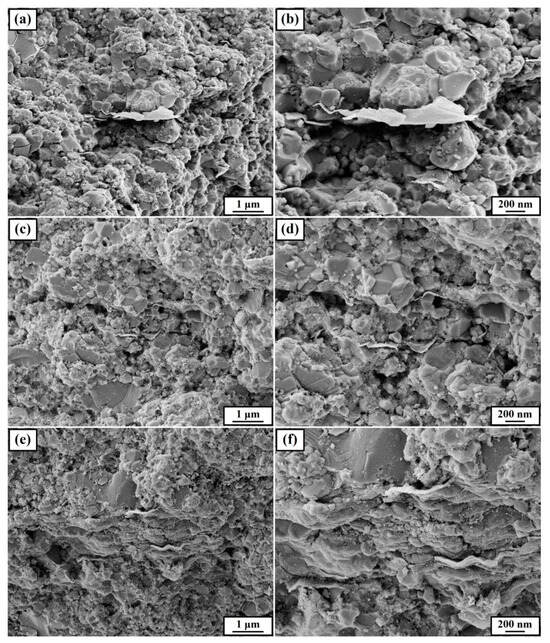
Figure 8.
FESEM images of the fracture surfaces of ATB–GX series ceramic materials with different amounts of GO: (a,b) ATB–G1.5, (c,d) ATB–G3.0, and (e,f) ATB–G4.5.
According to the comparative analysis in Figure 7 and Figure 8, it can be seen that the addition of Al2O3–RGO nanoparticles can effectively improve the dispersion level of graphene in the ceramic matrix and increase the density of the ceramic materials, compared with the ceramic materials with a single reinforcing phase GO as the initial addition phase. At the same time, due to the addition of Al2O3–RGO nanoparticles, a strong interfacial bonding strength is formed between RGO nanosheets and the matrix material, which improves the load transfer efficiency between RGO nanosheets and the ceramic matrix, and thus improves the overall mechanical properties of the ceramic materials.
3.4. Interface Characteristics of the As-Prepared Ceramic Materials
Figure 9 illustrates the HRTEM and TEM images of the ATB–RG3.0 ceramic material with 3.0 vol.% Al2O3–RGO nanoparticles. As depicted in Figure 9a, the RGO nanosheets were evenly distributed and intertwined to form a 3D grid structure, which is similar to what is observed in the FESEM micrograph (Figure 7). This unique microstructure is essential to the process of load transfer between RGO nanosheets and ceramic materials. As can be seen from Figure 9b, the thickness of RGO nanosheets uniformly distributed around the ceramic grains is about 5 to 10 nm, which indicates the effectiveness and success of our strategy to disperse RGO nanosheets. Figure 9c shows a high-resolution transmitted image of the enclosed area A of the frame shown in Figure 9a. It can be clearly observed from Figure 9c that the lattice spacing of the fringes is 0.35 nm, 0.27 nm, and 0.26 nm, which correspond to the (002) crystal plane of graphene, the (1011) crystal plane of TiB2, and the (104) crystal plane of Al2O3, respectively, indicating that there are two kinds of interfaces between RGO and Al2O3 and between RGO and TiB2 in this region. It is evident from the inset in Figure 9c that only Al, Ti, and C elements are present in the EDS spectrogram of the indicated area in the dotted box, which indicates that there are two interfaces of RGO and TiB2 and RGO and Al2O3 in this region. It can be seen from the figure that there are no gaps and cracks at the two interfaces, and a closely combined interface is formed. Figure 9d is an enlarged view of the dotted box area in Figure 9a, which clearly shows an interplanar spacing (d) of 3.46 Å, which is equivalent to the standard lattice parameters for (002) planes of graphene. In the FFT, there is a fuzzy reflection corresponding to the 3.42 Å plane spacing, which corresponds highly precisely to the (002) graphite plane (d002 = 3.35 Å) or the principal plane of graphene. This is a typical diffraction pattern for multilayer graphene. This indicates that the modification of GO wafer surface significantly improves the bonding between reinforcement and matrix [44].
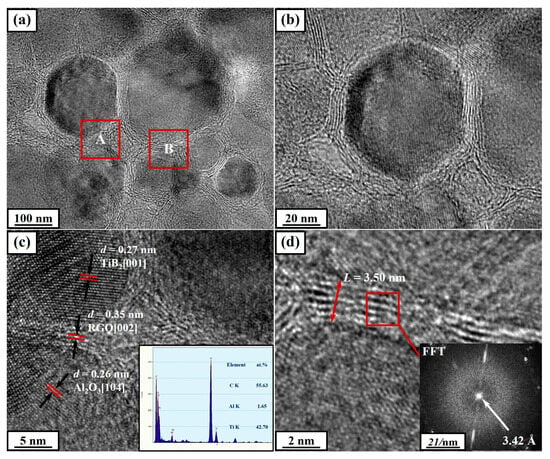
Figure 9.
TEM images of the ATB–RG3.0 ceramic material with 3.0 vol.% Al2O3–RGO: (a) dispersion of RGO in the ceramic material, (b) RGO wrapped around a grain, (c) HRTEM image of enclosed region A in (a) (the inset shows the EDS spectrogram of enclosed region A in (a)) and (d) HRTEM image of enclosed region B in (a) (the inset shows the SADP pattern of enclosed region B in (a)).
Images acquired from TEM and high-resolution TEM (HRTEM) for the 3.0 vol% GO-containing ATB–G3.0 ceramic material are displayed in Figure 10. The RGO nanosheets in the ATB–G3.0 ceramic material have a relatively substantial thickness, as shown in Figure 10a. The presence of multi-layer curling and significant overlap suggested that the sheets of RGO nanosheets were not evenly spread throughout the ceramic matrix. There were long and thin voids at the grain boundary, as shown in Figure 10b. The formation of voids is caused by RGO nanosheets falling off and agglomerating during the preparation process, which also suggested that the interface bonding between the materials and RGO nanosheets was weak. Figure 10c displays the HRTEM and fast Fourier transform (FFT) images corresponding to the dotted box area in Figure 10b. The FFT image displays two reflections that correspond to a crystal plane distance of 3.42 Å. The height of the reflection indicates the presence of either the (002) plane of graphite or the primary plane of graphene (d002 = 3.35 Å). This suggests that multi-layer graphene and amorphous carbon are simultaneously present at the triple point. Thus, the reinforcing efficiency of ceramic materials made with GO is significantly reduced due to the agglomeration caused by the van der Waals forces and the π–π stacking interaction present between the RGO nanosheets [45].
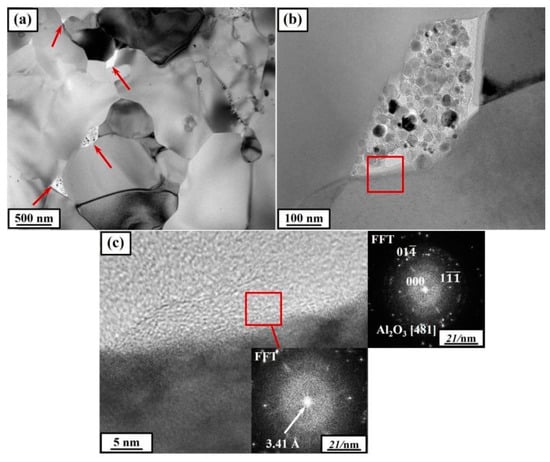
Figure 10.
TEM and HRTEM images of ATB–G3.0 ceramic materials with 3.0 vol.% GO: (a) dispersion of RGO nanosheets in ceramic material, (b) visible voids at the boundary of the grain, and (c) interfacial analysis.
3.5. Mechanical Characteristics of the As-Prepared Ceramic Materials
The impact of adding GO and Al2O3–RGO nanoparticles on the Vickers hardness of the prepared ceramics is presented in Figure 11. The hardness of the ATB–RGX ceramic materials peaked at 22.35 GPa for an Al2O3–RGO content of 1.5 vol.%, as illustrated in Figure 11a. The hardness of the ATB–RGX ceramic materials steadily declined, reaching 21.19 GPa for the ATB–RG3.0 ceramic materials, as the Al2O3–RGO content was increased further. According to Figure 11b, the ATB–RG3.0 ceramic materials had a hardness of 16.71 GPa when the GO content was 3.0 vol.%. This represented a decrease of 9.53% compared to ATB–RG0.0 ceramic materials. For the ATB–RG3.0 ceramic materials, the hardness increases by 5.68% and 16.82% compared with that of ATB–RG0.0 and ATB–G3.0 ceramic materials, respectively, reaching 19.52 GPa, indicating that the addition of Al2O3–RGO can effectively inhibit the hardness decrease caused, owing to the introduction of graphene [46].
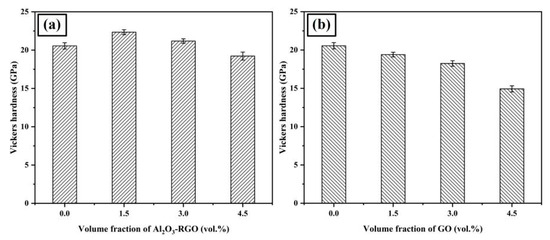
Figure 11.
Vickers hardness of (a) ATB–GRX series ceramic materials with different contents of Al2O3–RGO, and (b) ATB–GX series ceramic materials with different contents of GO.
The impact of GO and Al2O3–RGO additions on the flexural strength of ceramic materials was then examined. As illustrated in Figure 12a, the flexural strength of the prepared ATB–GRX ceramic materials increased as the Al2O3–RGO content was increased up to 3.0 vol.%, achieving a maximum value of 998.69 MPa at 3.0 vol.%. The flexural strength, however, declined with increasing Al2O3–RGO content. The ATB–G3.0 ceramic materials, comprising 3.0 vol.% GO, exhibited a flexural strength of 737.28 MPa, representing an increase of 18.29% in comparison to the ATB–RG0.0 ceramic materials. The flexural strength of the ATB–RG3.0 composite is 60.23% and 35.46% higher than that of the ATB–RG0.0 and ATB–G3.0 ceramic materials, respectively, illustrating that the incorporation of Al2O3–RGO to the materials results in a more pronounced enhancement in flexural strength when compared to the incorporation of GO.
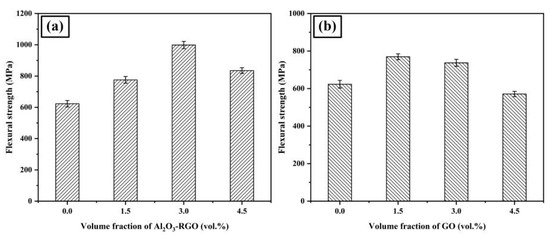
Figure 12.
Flexural strength of (a) ATB–RGX series ceramic materials with different contents of Al2O3–RGO, and (b) ATB–GX series ceramic materials with different contents of GO.
The impact of Al2O3–RGO and GO additions on the fracture toughness of the prepared materials is illustrated in Figure 13. According to Figure 13a, the fracture toughness increased with an increase in the Al2O3–RGO content. It reached its highest value at 8.42 MPa·m1/2 for 3.0 vol.% but then gradually dropped with higher Al2O3–RGO content. According to Figure 13b, the ATB–G3.0 ceramic materials, which had a GO content of 3.0 vol.%, exhibited a fracture toughness of 6.65 MPa·m1/2. This value represented a 23.61% increase in comparison to the ATB–RG0.0 ceramic materials. The fracture toughness of ATB–RG3.0 ceramic materials was 56.51% and 26.61% higher than that of the ATB–RG0.0 and ATB–G3.0 ceramic materials, respectively. In brief, the incorporation of Al2O3–RGO resulted in higher improvement in the fracture toughness of the ceramic materials.
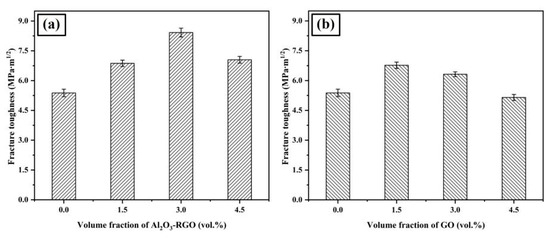
Figure 13.
Fracture toughness of (a) ATB–RGX series ceramic materials with different contents of Al2O3–RGO and (b) ATB–GX series ceramic materials with different contents of GO.
4. Strengthening and Toughening Mechanism
4.1. Dispersion Analysis of RGO
According to the results of microstructure characterization of ceramic materials, the distribution diagram of reinforcement phase in ceramic matrix materials with RGO nanosheets consisting of single reinforcement phase and Al2O3–RGO hybrid phase was drawn, as illustrated in Figure 14a,b. For the ceramic material with a single GO as the reinforcement phase, after hot-pressing sintering, RGO nanosheets are distributed vertically in the direction of hot pressing in ceramic materials. In addition, the van der Waals force between the RGO nanosheets and the large π–π force makes it easy to stack and agglomerate in the ceramic material, which seriously weakens its strengthening effect on the ceramic material. However, for the ceramic composite reinforced by the hybrid phase Al2O3–RGO nanoparticles, the RGO nanosheets were uniformly dispersed and constructed a three-dimensional grid structure in the ceramic materials.
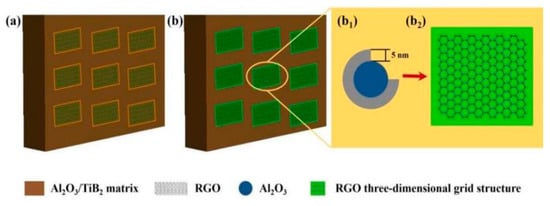
Figure 14.
Schematic diagram of RGO distribution in ceramic materials reinforced with (a) single GO and (b) hybrid Al2O3–RGO.
The influence of adding Al2O3–RGO nanoparticles and GO on the relative density of the ceramic materials is shown in Table 2. As shown in Table 2, the relative density of the ATB–RGX ceramic materials gradually decreases with increasing Al2O3–RGO content from 0.0 to 4.5 vol.%. However, when the Al2O3–RGO content is 3.0 vol.%, the relative density of the corresponding ATB–RG3.0 ceramic materials is still higher than 90%. As shown in Table 2, when the GO content is 3.0 vol.%, the relative density of the ATC–G3.0 ceramic materials is 86.12%, and when Al2O3–RGO content is 3.0 vol.%, the relative density of the ATB–RG3.0 ceramic materials is 92.67%. Therefore, the addition of Al2O3–RGO improves the compactness of the ceramic materials more effectively than the addition of GO.

Table 2.
Relative density of the as-prepared ceramic materials.
4.2. Load Transfer Analysis
Due to graphene’s excellent mechanical properties, large specific surface area and high aspect ratio, load transfer is generally considered to be the most effective strengthening mechanism in graphene-reinforced materials [47]. Generally, shear hysteresis models are used to estimate the strengthening effect of load transfer in materials [48]. Based on the established shear hysteresis model, the strength increase () due to load transfer in graphene-reinforced materials can be evaluated by the following equation [49,50]:
where is the yield strength of the matrix, is the thickness of graphene, is the transverse dimension of graphene, is the volume fraction of graphene, and is the yield shear strength of the matrix (the maximum value of is approximately half of the yield strength of the matrix [51]). It can be inferred from Equation (1) that the ratio of graphene transverse size to graphene thickness () is closely related to the mechanism of load transfer strengthening. It can be seen from Figure 14 that in the materials with Al2O3–RGO nanoparticles as a reinforcement phase, the RGO nanosheets are uniformly dispersed in it, thus forming a three-dimensional grid structure, which significantly increases the value of . Therefore, the actual load transfer efficiency is significantly higher than the theoretical value calculated by the above Formula (1), which is caused by the uniform dispersion of the RGO nanosheets and the increase in the effective length.
4.3. Grain Refinement Analysis
The effect of reinforcement on ceramic materials is the basis of improving the strength of composite materials. According to the existing research, even if a small amount of reinforcement phase is added to the ceramic material, it will produce obvious grain refinement effect. The microstructure and grain size distribution of the ATB–G@X series materials after thermal etching is shown in Figure 15. As illustrated in Figure 15a, in the absence of Al2O3–RGO nanoparticles, the mean grain size of the ATB–RG0.0 ceramic materials is approximately 2.57 ± 0.21 μm. As demonstrated in Figure 15b–d, the average grain size reduced to 1.87 ± 0.22, 1.56 ± 0.15, and 1.53 ± 0.12 μm, respectively, as the concentration of Al2O3–RGO rose to 1.5, 3.0, and 4.5 vol.%. In this study, the addition of Al2O3–RGO nanoparticles promotes grain refinement in ceramic materials for the following reasons: (1) The application of RGO coating to the surface of Al2O3 nanoparticles uniformly dispersed at the material’s grain boundary helps to stabilize the boundary of the grain and inhibits the formation of new grains [52]. (2) Owing to the comparatively high thermal conductivity of graphene (5300 W·m−1·K−1) [53], its uniform presence throughout the ceramic matrix not only helps to maintain a uniform temperature during sintering but also decreases the temperature of the ceramic grains. The sintering temperature is reduced to the ambient temperature at a higher rate. Graphene can play a similar role to a heat sink.
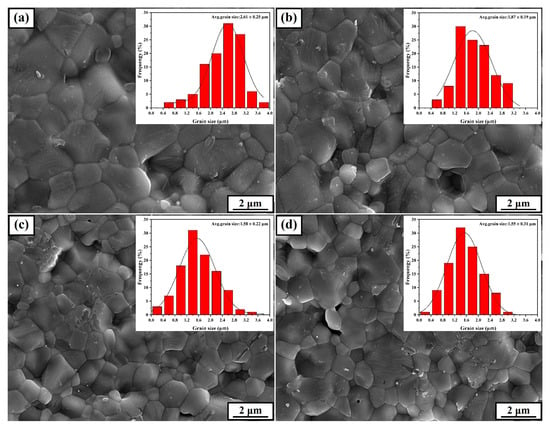
Figure 15.
Microstructure of ATB–RGX series ceramic materials and grain size variation with increasing Al2O3–RGO content: (a) ATB–RG0.0, (b) ATB–RG1.5, (c) ATB–RG3.0, and (d) ATB–RG4.5.
Figure 16 shows the microstructure and variation in the size of the ATB–G3.0 ceramic materials grains with 3.0 vol% GO and the ATB–RG3.0 ceramic materials with 3.0 vol% Al2O3–RGO, respectively. The average grain size of the ATB–G3.0 and ATB–RG3.0 ceramic materials is approximately 2.24 ± 0.17 μm and 1.56 ± 0.15 μm, respectively, demonstrating that the addition of Al2O3–RGO nanoparticles can promote the grain refinement of ceramic materials more effectively than the addition of GO. The enhancement in strength resulting from the refinement and strengthening of the grains can be calculated and analyzed using the Hall–Petch equation [54], whose expression is as follows:
where denotes a constant, and and represent the mean grain size of the composite material with and without graphene, respectively. The strengthening efficiency of grain refinement in ceramic materials increases with decreasing average grain size, as indicated by Equation (2). Consequently, the bending strength is further enhanced through grain refinement improvement. This explains that the bending strength of the ATB–RG3.0 ceramic materials is higher than that of the ATB–G3.0 ceramic materials.
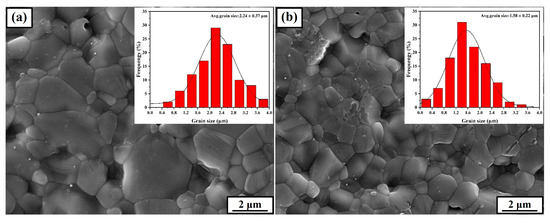
Figure 16.
Microstructure and grain size variation for different ceramic materials: (a) ATB–G3.0 and (b) ATB–RG3.0.
4.4. Toughening Mechanism
In order to further elucidate the strengthening mechanism of ceramic materials, the fracture behavior of ceramic materials was analyzed. In several groups of samples shown in Figure 17, the presence of significant deep dimples can be observed in Figure 17a,c. In the enlarged fracture image of the ceramic composite, it can be observed that there are obvious sheet RGO nanosheets in the dimpled (marked by white arrows in Figure 17d,f), which is in sharp contrast to the clean fracture surface of the pure ceramic composite, indicating that the RGO nanosheets have a significant impact on the fracture process of the ceramic composite. By comparison with Figure 17d,f, it can be found that obvious phenomenon of RGO nanosheets pulling out exists at the fracture of ATB–G3.0 ceramic materials with single GO as the reinforcement phase, while in ATB–RG3.0 ceramic materials with hybrid Al2O3–RGO nanoparticles as the reinforcement phase, RGO nanosheets are tightly nested in the ceramic matrix. The results show that RGO nanosheets fracture during the fracture of ceramic materials.
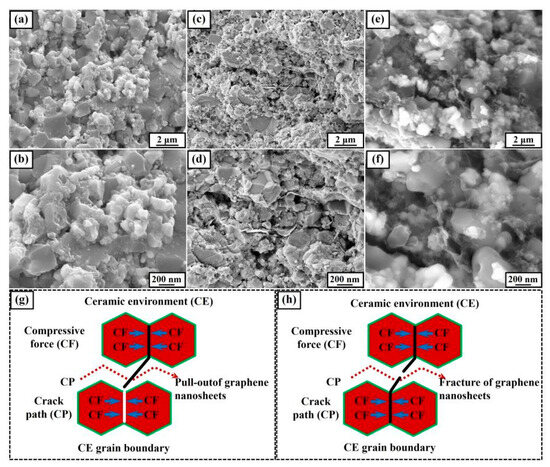
Figure 17.
FESEM images of the fracture surfaces of different ceramic materials: (a,b) ATB–RG0.0, (c,d) ATB–G3.0, and (e,f) ATB–RG3.0. Schematic diagrams of fracture mechanisms (g) GO and (h) Al2O3–RGO.
According to fracture behavior analysis, the ATB–G3.0 ceramic materials with single GO as the reinforcement phase and the ATB–RG3.0 ceramic materials with hybrid Al2O3–RGO nanoparticles as the reinforcement phase have two different fracture behaviors, and their schematic diagrams are shown in Figure 18. In the ATB–G3.0 ceramic materials with a single GO as the reinforcement phase, the pulling out of the RGO nanosheets at the fracture indicates the mechanical bonding between the ceramic matrix and the RGO nanosheets [55]. Generally speaking, mechanical bonding is a weak interface bonding. By adding GO to the ceramic matrix, a weak interface region is formed between RGO nanosheets and the ceramic matrix due to the difficulty of uniform dispersion of RGO nanosheets, and cracks can move along the weak interface. This induces traditional toughening mechanisms such as crack bridging (Figure 18b), crack branching (Figure 18c), crack deflection (Figure 18d), and pull-out (Figure 18e), which are thought to dissipate large amounts of fracture energy to improve the fracture toughness of the ceramic material [25]. However, the fracture of RGO nanosheets (Figure 18f) shows that the hybrid reinforced phase Al2O3–RGO nanoparticles have a stronger interface bonding between the ceramic matrix and RGO nanosheets than the single reinforced phase (GO). Through the interaction between graphene and nano-alumina particles, the removal of RGO nanosheets is inhibited, which is conducive to the transfer of load from the ceramic to the RGO nanosheets, and the strength of the composite material is improved. It also shows that RGO nanosheets with good interfacial transition play a role in bridging cracks during the fracture process, which will greatly consume the fracture energy. Even if RGO nanosheets eventually break, the elastic vibration will increase the energy consumption and improve the toughness of the ceramic materials [56].
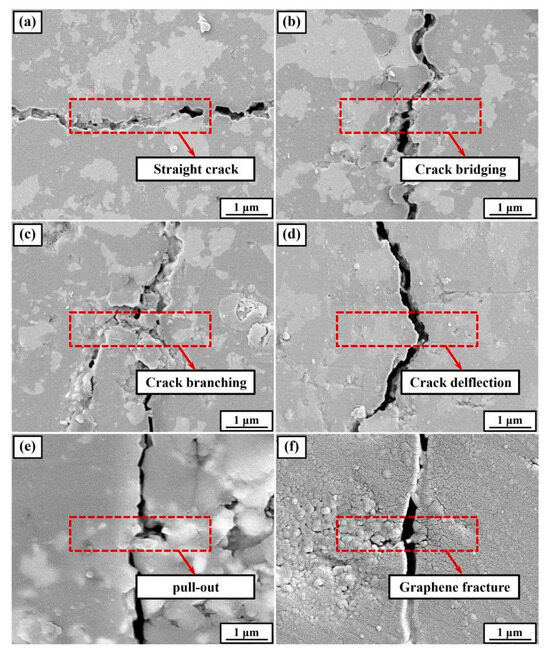
Figure 18.
Crack propagation in the ATB–RG3.0 ceramic materials: (a) straight crack, (b) crack bridging, (c) crack branching, (d) crack defection, (e) pull-out, and (f) RGO fracture.
4.5. Fracture Mechanism
A reinforcement model of ceramic materials has been established to better understand the fracture mechanism of ceramic composite, as shown in Figure 19. The schematic diagrams of strengthening models of ATB–G3.0 and ATB–RG3.0 ceramic materials are shown in Figure 19a and Figure 19b, respectively. As shown in Figure 19a, when the applied load is transferred from the ceramic matrix to the RGO nanosheets along the direction (parallel to RGO axis), due to the low interface-bonding strength between the RGO and matrix, the RGO is easily pulled out of the matrix. In this case, the effect of RGO in strengthening ceramic materials is poor. When the applied load is transferred from ceramic matrix to RGO nanosheets in the direction (perpendicular to RGO axis), the interface between RGO and ceramic matrix is prone to crack under the action of external load, and RGO is easily pulled out of the ceramic matrix, and its strengthening effect is still poor.
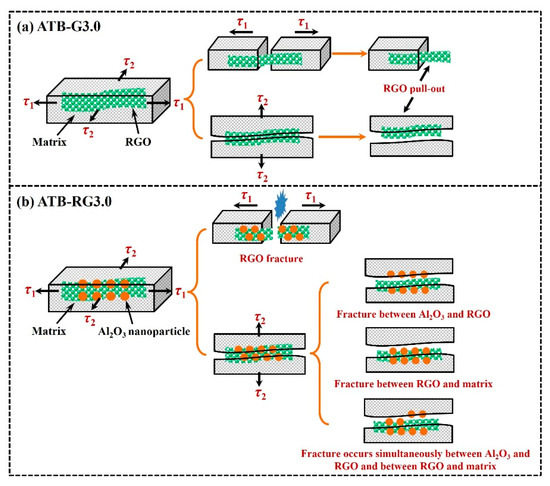
Figure 19.
Schematic diagram of strengthening model of ceramic materials: (a) ATB–G3.0 and (b) ATB–RG3.0.
As shown in Figure 19b, when the applied load is transferred from ceramic matrix to RGO nanosheets along the direction (parallel to RGO axis), a strong interface bond is formed between RGO and ceramic matrix due to the “bridging” effect of Al2O3 nanoparticles. At this time, RGO is easy to be pulled apart under the action of external load. This shows that Al2O3–RGO nanoparticles has a remarkable effect on load transfer strengthening in ceramic materials. When the applied load is transferred from ceramic matrix to RGO in the direction (perpendicular to RGO axis), there are three possible situations for fracture: (1) disconnect along the interface between RGO and Al2O3 nanoparticles; (2) disconnect along the interface between RGO and ceramic matrix; (3) disconnect along the interface between RGO and Al2O3 nanoparticles and the interface between RGO and ceramic matrix at the same time.
In summary, compared with GO, the addition of Al2O3–RGO nanoparticles improves the interface-bonding strength between the graphene and ceramic matrix, prolongs the crack path and consumes higher fracture energy, which may be related to the mechanical properties existing on the surface of large graphene lamellae, consumes the driving force of crack growth, and inhibits crack growth. Therefore, the introduction of Al2O3–RGO nanoparticles have a substantial effect on the load transfer strengthening of ceramic materials.
5. Conclusions
The findings suggest that the implemented self-assembly technique successfully generated a uniform RGO coating on the surface of Al2O3 nanoparticles. In comparison to GO addition, the addition of Al2O3–RGO nanoparticles to the Al2O3/TiB2 matrix can significantly improve the dispersion level of RGO in the ceramic materials and reduce defects such as pores and micro-cracks caused by graphene agglomeration, which is more advantageous for increasing the density of ceramic materials. In addition, based on the microstructure observation, it is observed that the ceramic materials reinforced with Al2O3–RGO nanoparticles has better interfacial bonding strength. Good interfacial strength not only facilitates load transfer from the substrate to the RGO nanosheets but also influences the fracture process of the RGO nanosheets, which is distinct from the typical toughening method. This microstructural enhancement significantly improves the mechanical characteristics of ceramic materials.
Author Contributions
Y.H.: Investigation, Data curation, Writing-original draft, Writing—review & editing. Z.F.: Methodology, Writing—review & editing. Y.X.: Formal analysis, Funding acquisition, Writing—review & editing. H.W.: Supervision, Writing—review & editing. Q.J.: Methodology, Writing—review & editing. J.W.: Validation, Writing—review & editing. C.X.: Conceptualization, Resources, Writing—review & editing, Project administration. All authors have read and agreed to the published version of the manuscript.
Funding
This study is funded by the Project of Weifang City Science and Technology Development Plan (Grant No. 2023GX039).
Data Availability Statement
The original contributions presented in the study are included in the article, further inquiries can be directed to the corresponding author.
Conflicts of Interest
The authors declare that they have no known competing financial interests or personal relationships that could have appeared to influence the work reported in this paper.
References
- Zhang, K.; He, R.; Ding, G.; Bai, X.; Fang, D. Effects of fine grains and sintering additives on stereolithography additive manufactured Al2O3 ceramic. Ceram Int. 2021, 47, 2303–2310. [Google Scholar] [CrossRef]
- Kim, W.; Oh, H.S.; Shon, I.J. The effect of graphene reinforcement on the mechanical properties of Al2O3 ceramics rapidly sintered by high-frequency induction heating. Int. J. Refract. Met. Hard Mater. 2015, 48, 376–381. [Google Scholar] [CrossRef]
- Zou, Y.; Li, C.H.; Liu, J.A.; Wu, J.M.; Hu, L.; Gui, R.F.; Shi, Y.S. Towards fabrication of high-performance Al2O3 ceramics by indirect selective laser sintering based on particle packing optimization. Ceram. Int. 2019, 45, 12654–12662. [Google Scholar] [CrossRef]
- Gutiérrez-González, C.F.; Suárez, M.; Pozhidaev, S.; Rivera, S.; Peretyagin, P.; Solís, W.; Diaz, L.A.; Fernandez, A.; Torrecillas, R. Effect of TiC addition on the mechanical behaviour of Al2O3-SiC whiskers materials obtained by SPS. J. Eur. Ceram. Soc. 2016, 36, 2149–2152. [Google Scholar] [CrossRef]
- Papageorgiou, D.G.; Kinloch, I.A.; Young, R.J. Mechanical properties of graphene and graphene-based nanomaterials. Prog. Mater. Sci. 2017, 90, 75–127. [Google Scholar] [CrossRef]
- Yin, Z.; Huang, C.; Zou, B.; Liu, H.; Zhu, H.; Wang, J. Study of the mechanical properties, strengthening and toughening mechanisms of Al2O3/TiC micro-nano-composite ceramic tool material. Mater. Sci. Eng. A 2013, 577, 9–15. [Google Scholar] [CrossRef]
- Taha, M.A.; Nassar, A.H.; Zawrah, M.F. Improvement of wetability, sinterability, mechanical and electrical properties of Al2O3-Ni nanomaterials prepared by mechanical alloying. Ceram. Int. 2017, 43, 3576–3582. [Google Scholar] [CrossRef]
- Lin, J.; Huang, Y.; Zhang, H. Damage resistance, R-curve behavior and toughening mechanisms of ZrB2-based materials with SiC whiskers and ZrO2 fibers. Ceram. Int. 2015, 41, 2690–2698. [Google Scholar] [CrossRef]
- Guo, G.; Fan, Y.; Zhang, J.F.; Hagan, J.L.; Xu, X. Novel dental materials reinforced with zirconia–silica ceramic nanofibers. Dent. Mater. 2012, 28, 360–368. [Google Scholar] [CrossRef]
- Zhang, B.; Zhang, X.; Hong, C.; Qiu, Y.; Zhang, J.; Han, J.; Hu, P. Electrostatic assembly preparation of high-toughness zirconium diboride-based ceramic materials with enhanced thermal shock resistance performance. ACS Appl. Mater. Interfaces 2016, 8, 11675–11681. [Google Scholar] [CrossRef]
- Li, D.; Yang, Z.; Jia, D.; Wu, D.; Zhu, Q.; Liang, B.; Wang, S.; Zhou, Y. Microstructure, oxidation and thermal shock resistance of graphene reinforced SiBCN ceramics. Ceram. Int. 2016, 42, 4429–4444. [Google Scholar] [CrossRef]
- Georgakilas, V.; Otyepka, M.; Bourlinos, A.B.; Chandra, V.; Kim, N.; Kemp, K.C.; Hobza, P.; Zboril, R.; Kim, K.S. Functionalization of graphene: Covalent and non-covalent approaches, derivatives and applications. Chem. Rev. 2012, 112, 6156–6214. [Google Scholar] [CrossRef] [PubMed]
- Guan, L.Z.; Wan, Y.J.; Gong, L.X.; Yan, D.; Tang, L.C.; Wu, L.B.; Jiang, J.X.; Lai, G.Q. Toward effective and tunable interphases in graphene oxide/epoxy materials by grafting different chain lengths of polyetheramine onto graphene oxide. J. Mater. Chem. A 2014, 2, 15058–15069. [Google Scholar] [CrossRef]
- Liu, Y.; Jiang, X.; Shi, J.; Luo, Y.; Tang, Y.; Wu, Q.; Luo, Z. Research on the interface properties and strengthening-toughening mechanism of nanocarbon-toughened ceramic matrix materials. Nanotechnol. Rev. 2020, 9, 190–208. [Google Scholar] [CrossRef]
- Wazalwar, R.; Tripathi, N.; Raichur, A.M. Mechanical and curing behavior of epoxy materials reinforced with polystyrene-graphene oxide (PS-GO) core-shell particles. Part C Open Access 2021, 5, 100128. [Google Scholar] [CrossRef]
- Boostani, A.F.; Tahamtan, S.; Jiang, Z.; Wei, D.; Yazdani, S.; Khosroshahi, R.A.; Mousavian, R.T.; Xu, J.; Zhang, X.; Gong, D. Enhanced tensile properties of aluminium matrix materials reinforced with graphene encapsulated SiC nanoparticles. Compos. Part A Appl. Sci. Manuf. 2015, 68, 155–163. [Google Scholar] [CrossRef]
- Nazarian-Samani, M.; Kim, H.K.; Park, S.H.; Youn, H.C.; Mhamane, D.; Lee, S.W.; Kim, M.-S.; Jeong, J.-H.; Haghighat-Shishavan, S.; Roh, K.-C.; et al. Three-dimensional graphene-based spheres and crumpled balls: Micro-and nano-structures, synthesis strategies, properties and applications. RSC Adv. 2016, 6, 50941–50967. [Google Scholar] [CrossRef]
- Nieto, A.; Bisht, A.; Lahiri, D.; Zhang, C.; Agarwal, A. Graphene reinforced metal and ceramic matrix materials: A review. Int. Mater. Rev. 2017, 62, 241–302. [Google Scholar] [CrossRef]
- Huang, L.; Zhu, P.; Li, G.; Lu, D.D.; Sun, R.; Wong, C. Core-shell SiO2@RGO hybrids for epoxy materials with low percolation threshold and enhanced thermo-mechanical properties. J. Mater. Chem. A 2014, 2, 18246–18255. [Google Scholar] [CrossRef]
- Che, Y.; Sun, Z.; Zhan, R.; Wang, S.; Zhou, S.; Huang, J. Effects of graphene oxide sheets-zirconia spheres nanohybrids on mechanical, thermal and tribological performances of epoxy materials. Ceram. Int. 2018, 44, 18067–18077. [Google Scholar] [CrossRef]
- Doan, V.C.; Vu, M.C.; Islam, M.A.; Kim, S.R. Poly (methyl methacrylate)-functionalized reduced graphene oxide-based core-shell structured beads for thermally conductive epoxy materials. J. Appl. Polym. Sci. 2019, 136, 47377. [Google Scholar] [CrossRef]
- Chen, L.; Zhao, P.; Xie, H.; Yu, W. Thermal properties of epoxy resin based thermal interfacial materials by filling Ag nanoparticle-decorated graphene nanosheets. Compos. Sci. Technol. 2016, 125, 17–21. [Google Scholar] [CrossRef]
- Hu, Y.; Chen, Z.; Zhang, J.; Xiao, G.; Yi, M.; Zhang, W.; Xu, C. Preparation and mechanical properties of Si3N4 nanomaterials reinforced by Si3N4@rGO particles. J. Am. Ceram. Soc. 2019, 102, 6991–7002. [Google Scholar] [CrossRef]
- Ma, M.; Wang, H.; Xiong, L.; Huang, S.; Li, X.; Du, X. Self-assembled homogeneous SiOC@C/graphene with three-dimensional lamellar structure enabling improved capacity and rate performances for lithium ion storage. Carbon 2022, 186, 273–281. [Google Scholar] [CrossRef]
- Hu, Y.; Xie, Y.; Xin, H.; Chen, J.; Li, Y.; Xu, C. Nano/microstructures and mechanical properties of Al2O3-TiC ceramic materials reinforced with Al2O3@RGO nanohybrids. Ceram. Int. 2022, 48, 27536–27549. [Google Scholar] [CrossRef]
- Hummers, W.S., Jr.; Offeman, R.E. Preparation of graphitic oxide. J. Am. Ceram. Soc. 1958, 80, 1339. [Google Scholar] [CrossRef]
- Guerrero-Contreras, J.; Caballero-Briones, F. Graphene oxide powders with different oxidation degree, prepared by synthesis variations of the Hummers method. Mater. Chem. Phys. 2015, 153, 209–220. [Google Scholar] [CrossRef]
- Fan, Y.; Zhang, G.; Li, Y. Study on graphene oxide reinforced magnesium phosphate cement materials. Constr. Build. Mater. 2022, 359, 129523. [Google Scholar] [CrossRef]
- Luo, J.; Li, X.; Yan, W.; Shu, P.; Mei, J. RGO supported bimetallic MOFs-derived Co/MnO/porous carbon composite toward broadband electromagnetic wave absorption. Carbon 2023, 205, 552–561. [Google Scholar]
- Verma, S.; Pandey, V.K.; Verma, B. Facile synthesis of graphene oxide-polyaniline-copper cobaltite (GO/PANI/CuCo2O4) hybrid nanocomposite for supercapacitor applications. Synth Met. 2022, 286, 117036. [Google Scholar] [CrossRef]
- Ye, D.M.; Li, G.Z.; Wang, G.G.; Lin, Z.Q.; Zhou, H.L.; Han, M.; Liu, Y.L.; Han, J.C. One-pot synthesis of copper nanowire decorated by reduced graphene oxide with excellent oxidation resistance and stability. Appl. Surf. Sci. 2019, 467, 158–167. [Google Scholar] [CrossRef]
- Dao, T.D.; Lee, H.I.; Jeong, H.M. Alumina-coated graphene nanosheet and its composite of acrylic rubber. J. Colloid Interface Sci. 2014, 416, 38–43. [Google Scholar] [CrossRef]
- Gholampour, A.; Kiamahalleh, M.V.; Tran, D.N.; Ozbakkaloglu, T.; Losic, D. From graphene oxide to reduced graphene oxide: Impact on the physiochemical and mechanical properties of graphene-cement materials. ACS Appl. Mater. Interfaces 2017, 9, 43275–43286. [Google Scholar] [CrossRef]
- Du, Y.; Yang, J.; Thomas, B.S.; Li, L.; Li, H.; Shaban, W.M.; Chong, W.T. Influence of hybrid graphene oxide/carbon nanotubes on the mechanical properties and microstructure of magnesium potassium phosphate cement paste. Constr. Build. Mater. 2020, 260, 120449. [Google Scholar] [CrossRef]
- Guo, R.; Zhao, L.; Yue, W. Assembly of core-shell structured porous carbon-graphene materials as anode materials for lithium-ion batteries. Electrochim. Acta 2015, 152, 338–344. [Google Scholar] [CrossRef]
- Huang, H.H.; De Silva, K.K.; Kumara, G.; Yoshimura, M. Structural evolution of hydrothermally derived reduced graphene oxide. Sci. Rep. 2018, 8, 6849. [Google Scholar] [CrossRef]
- López-Díaz, D.; Holgado, M.L.; García-Fierro, J.L.; Velázquez, M.M. Evolution of the Raman spectrum with the chemical composition of graphene oxide. J. Phys. Chem. C 2017, 121, 20489–20497. [Google Scholar] [CrossRef]
- Xu, Y.T.; Guo, Y.; Song, L.X.; Zhang, K.; Yuen, M.M.; Xu, J.B.; Fu, X.Z.; Sun, R.; Wong, C.P. Co-reduction self-assembly of reduced graphene oxide nanosheets coated Cu2O sub-microspheres core-shell materials as lithium ion battery anode materials. Electrochim. Acta 2015, 176, 434–441. [Google Scholar] [CrossRef]
- Gupta, A.; Chen, G.; Joshi, P.; Tadigadapa, S.; Eklund, P.C. Raman scattering from high-frequency phonons in supported n-graphene layer films. Nano Lett. 2006, 6, 2667–2673. [Google Scholar] [CrossRef]
- Wu, Y.; Zhu, J.; Huang, L. A review of three-dimensional graphene-based materials: Synthesis and applications to energy conversion/storage and environment. Carbon 2019, 143, 610–640. [Google Scholar] [CrossRef]
- Shao, G.; Hanaor, D.A.; Wang, J.; Kober, D.; Li, S.; Wang, X.; Shen, X.; Bekheet, M.F.; Gurlo, A. Polymer-derived SiOC integrated with a graphene aerogel as a highly stable Li-ion battery anode. ACS Appl. Mater. Interfaces 2020, 12, 46045–46056. [Google Scholar] [CrossRef]
- Xu, G.; Du, S.; He, J.; Shi, X. The role of admixed graphene oxide in a cement hydration system. Carbon 2019, 148, 141–150. [Google Scholar] [CrossRef]
- Hu, Y.; Xu, C.; Xiao, G.; Yi, M.; Chen, Z.; Zhang, J. Electrostatic self-assembly preparation of reduced graphene oxide-encapsulated alumina nanoparticles with enhanced mechanical properties of alumina nanomaterials. J. Eur. Ceram. Soc. 2018, 38, 5122–5133. [Google Scholar] [CrossRef]
- Wozniak, J.; Jastrzębska, A.; Cygan, T.; Olszyna, A. Surface modification of graphene oxide nanoplatelets and its influence on mechanical properties of alumina matrix materials. J. Eur. Ceram. Soc. 2017, 37, 1587–1592. [Google Scholar] [CrossRef]
- Wang, K.; Wang, Y.; Fan, Z.; Yan, J.; Wei, T. Preparation of graphene nanosheet/alumina materials by spark plasma sintering. Mater. Res. Bull. 2011, 46, 315–318. [Google Scholar] [CrossRef]
- Liu, F.; Wang, M.; Chen, Y.; Gao, J.; Ma, T. Mechanical properties and microstructure of reaction sintering SiC ceramics reinforced with graphene-based fillers. Appl. Phys. A. 2019, 125, 680. [Google Scholar] [CrossRef]
- Chu, K.; Wang, F.; Li, Y.B.; Wang, X.H.; Huang, D.J.; Zhang, H. Interface structure and strengthening behavior of graphene/CuCr materials. Carbon 2018, 133, 127–139. [Google Scholar] [CrossRef]
- Bisht, A.; Srivastava, M.; Kumar, R.M.; Lahiri, I.; Lahiri, D. Strengthening mechanism in graphene nanoplatelets reinforced aluminum composite fabricated through spark plasma sintering. Mater. Sci. Eng. A 2017, 695, 20–28. [Google Scholar] [CrossRef]
- Li, M.; Zhang, Z.; Gao, H.; Wang, Y.; Liang, J.; Shu, D.; Wang, J.; Sun, B. Formation of multilayer interfaces and the load transfer in graphene nanoplatelets reinforced Al matrix materials. Mater. Charact. 2020, 159, 110018. [Google Scholar] [CrossRef]
- Xiong, B.; Liu, K.; Yan, Q.; Xiong, W.; Wu, X. Microstructure and mechanical properties of graphene nanoplatelets reinforced Al matrix materials fabricated by spark plasma sintering. J. Alloys Compd. 2020, 837, 155495. [Google Scholar]
- Chen, B.; Shen, J.; Ye, X.; Imai, H.; Umeda, J.; Takahashi, M.; Kondoh, K. Solid-state interfacial reaction and load transfer efficiency in carbon nanotubes (CNTs)-reinforced aluminum matrix materials. Carbon 2017, 114, 198–208. [Google Scholar] [CrossRef]
- Zhang, X.; Xu, Y.; Wang, M.; Liu, E.; Zhao, N.; Shi, C.; Lin, D.; Zhu, F.; He, C. A powder-metallurgy-based strategy toward three-dimensional graphene-like network for reinforcing copper matrix materials. Nat. Commun. 2020, 11, 2775. [Google Scholar] [CrossRef]
- Steurer, P.; Wissert, R.; Thomann, R.; Mülhaupt, R. Functionalized graphenes and thermoplastic nanomaterials based upon expanded graphite oxide. Macromol. Rapid. Commun. 2009, 30, 316–327. [Google Scholar] [CrossRef]
- Hansen, N. Hall-Petch relation and boundary strengthening. Scr. Mater. 2004, 51, 801–806. [Google Scholar] [CrossRef]
- Wang, Y.; Zhou, Q.; Han, Z.; Han, Y.; Bi, L.; Zhang, X.; Lu, X.; Zhao, J.; Chu, W.; Li, J.; et al. Towards high strengthening efficiency of equiaxed and platelet-shaped alumina reinforced zirconia ceramics with textured microstructure using DLP-based stereolithography. Ceram. Int. 2024, 50, 2467–2478. [Google Scholar] [CrossRef]
- Guo, S.; Zhang, X.; Shi, C.; Liu, E.; He, C.; He, F.; Zhao, N. Enhanced mechanical properties and electrical conductivity of graphene nanoplatelets/Cu materials by in situ formation of Mo2C nanoparticles. Mater. Sci. Eng. A 2019, 766, 138365. [Google Scholar] [CrossRef]
Disclaimer/Publisher’s Note: The statements, opinions and data contained in all publications are solely those of the individual author(s) and contributor(s) and not of MDPI and/or the editor(s). MDPI and/or the editor(s) disclaim responsibility for any injury to people or property resulting from any ideas, methods, instructions or products referred to in the content. |
© 2024 by the authors. Licensee MDPI, Basel, Switzerland. This article is an open access article distributed under the terms and conditions of the Creative Commons Attribution (CC BY) license (https://creativecommons.org/licenses/by/4.0/).